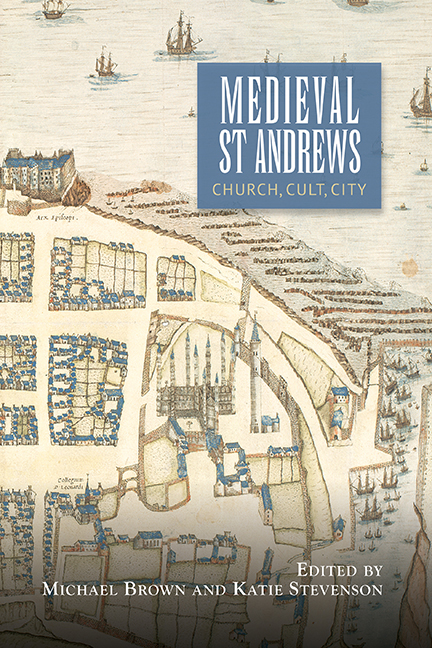Book contents
- Frontmatter
- Dedication
- Contents
- List of Illustrations, Charts and Tables
- Contributors
- Abbreviations
- 1 ‘Ancient Magnificence’: St Andrews in the Middle Ages: An Introduction
- 2 From Cinrigh Monai to Civitas Sancti Andree: A Star is Born
- 3 The Idea of St Andrews as the Second Rome Made Manifest
- 4 The Medieval Ecclesiastical Architecture of St Andrews as a Channel for the Introduction of New Ideas
- 5 When the Miracles Ceased: Shrine and Cult Management at St Andrews and Scottish Cathedrals in the Later Middle Ages
- 6 Religion, Ritual and the Rhythm of the Year in Later Medieval St Andrews
- 7 Living in the Late Medieval Town of St Andrews
- 8 The Burgh of St Andrews and its Inhabitants before the Wars of Independence
- 9 The Archaeology of Medieval St Andrews
- 10 Prelates, Citizens and Landed Folk: St Andrews as a Centre of Lordship in the Late Middle Ages
- 11 Augmenting Rentals: The Expansion of Church Property in St Andrews, c. 1400–1560
- 12 The Prehistory of the University of St Andrews
- 13 University, City and Society
- 14 The Medieval Maces of the University of St Andrews
- 15 Heresy, Inquisition and Late Medieval St Andrews
- Appendix 1 The St Andrews Foundation Account
- Appendix 2 The Augustinian' Account
- Appendix 3 The Boar' Raik
- Appendix 4 University of St Andrews Library, UYSL 110/6/4
- Index
- Miscellaneous Endmatter
1 - ‘Ancient Magnificence’: St Andrews in the Middle Ages: An Introduction
Published online by Cambridge University Press: 28 April 2017
- Frontmatter
- Dedication
- Contents
- List of Illustrations, Charts and Tables
- Contributors
- Abbreviations
- 1 ‘Ancient Magnificence’: St Andrews in the Middle Ages: An Introduction
- 2 From Cinrigh Monai to Civitas Sancti Andree: A Star is Born
- 3 The Idea of St Andrews as the Second Rome Made Manifest
- 4 The Medieval Ecclesiastical Architecture of St Andrews as a Channel for the Introduction of New Ideas
- 5 When the Miracles Ceased: Shrine and Cult Management at St Andrews and Scottish Cathedrals in the Later Middle Ages
- 6 Religion, Ritual and the Rhythm of the Year in Later Medieval St Andrews
- 7 Living in the Late Medieval Town of St Andrews
- 8 The Burgh of St Andrews and its Inhabitants before the Wars of Independence
- 9 The Archaeology of Medieval St Andrews
- 10 Prelates, Citizens and Landed Folk: St Andrews as a Centre of Lordship in the Late Middle Ages
- 11 Augmenting Rentals: The Expansion of Church Property in St Andrews, c. 1400–1560
- 12 The Prehistory of the University of St Andrews
- 13 University, City and Society
- 14 The Medieval Maces of the University of St Andrews
- 15 Heresy, Inquisition and Late Medieval St Andrews
- Appendix 1 The St Andrews Foundation Account
- Appendix 2 The Augustinian' Account
- Appendix 3 The Boar' Raik
- Appendix 4 University of St Andrews Library, UYSL 110/6/4
- Index
- Miscellaneous Endmatter
Summary
SET along its rocky outcrop between two long sandy beaches, the St Andrews skyline is dominated by its medieval buildings. The towers of the churches of St Salvator, Holy Trinity and St Regulus, the gables of the cathedral and the remains of the castle retain a visual prominence. These buildings are reminders of the status and wealth of St Andrews between the twelfth and sixteenth centuries. In this era St Andrews was a centre of unique significance in Scotland. It could claim to be the ecclesiastical capital of the land. St Andrews was the seat of the leading bishop, and from 1472 the archbishop, of Scotland whose diocese was both the richest in the Scottish church and included the core regions of the kingdom. Its cathedral was by far the largest church (and the largest building) in medieval Scotland and housed relics of the figure increasingly adopted as the nation's patron saint. The long history of scholarship at this site was reflected by the foundation of the first Scottish university in 1413. Though removed from the natural routes between royal residences and the largest burghs, and possessing a rich, but relatively small, hinterland, medieval St Andrews’ claims to be a city rested less on size than on the status provided to an urban community which grew under the wing of powerful clerical patrons and benefited from the flow of clergy, pilgrims and students through its streets and dwellings.
However, the ruinous state of the cathedral, the castle and several of the churches has also been a reminder to modern visitors of the violent closing of the era of St Andrews’ greatest significance in the second half of the sixteenth century. The destruction, neglect and loss of status caused by the Scottish Reformation had a devastating effect on the fortunes of the town. Even in the earliest depiction of the city, drawn by John Geddy around 1580, St Andrews shows the scars of recent upheaval. The cathedral and the churches of the Black and Grey Friars are shown as roofless and uninhabited. These are scars that were never healed. When he included St Andrews in his Scottish tour in 1773, Dr Johnson described it as ‘a city, which only history shews to have once flourished’ as he ‘surveyed the ruins of ancient magnificence’. The ruins and decline struck not only Johnson but also Sir Walter Scott.
- Type
- Chapter
- Information
- Medieval St AndrewsChurch, Cult, City, pp. 1 - 19Publisher: Boydell & BrewerPrint publication year: 2017

